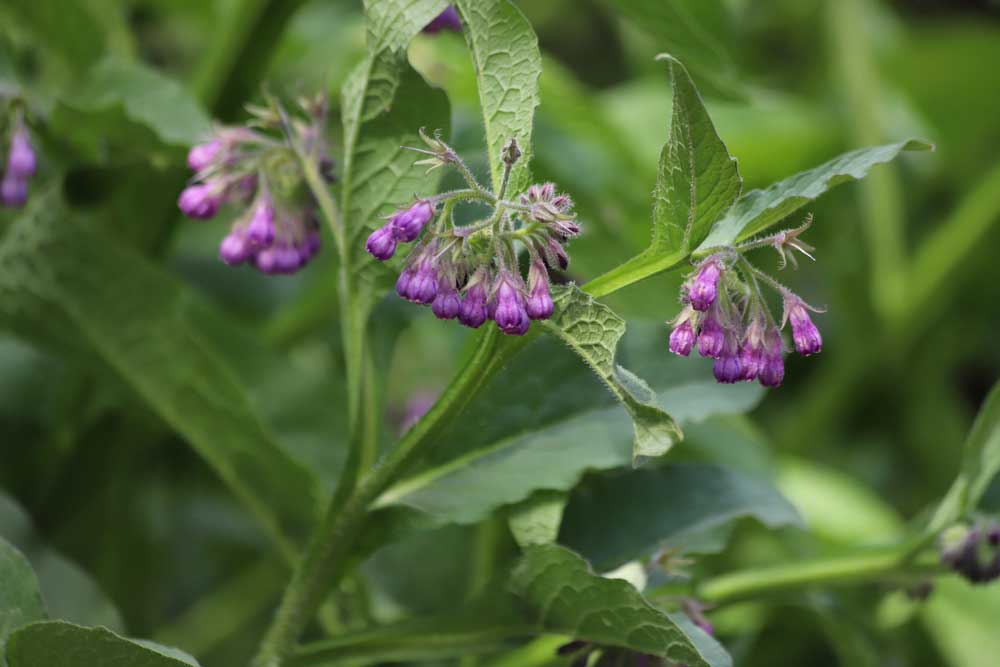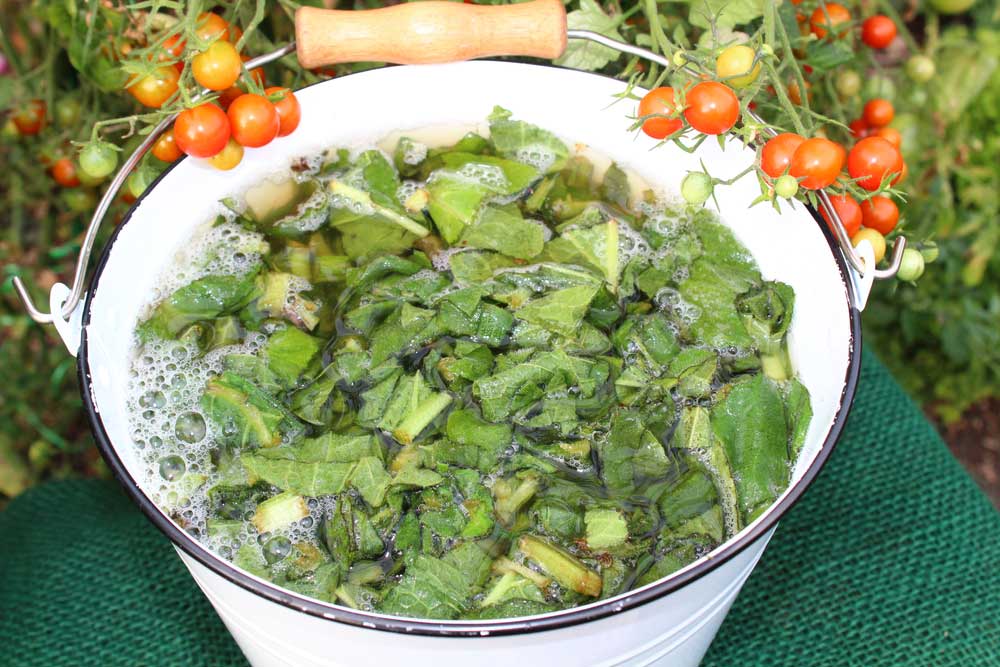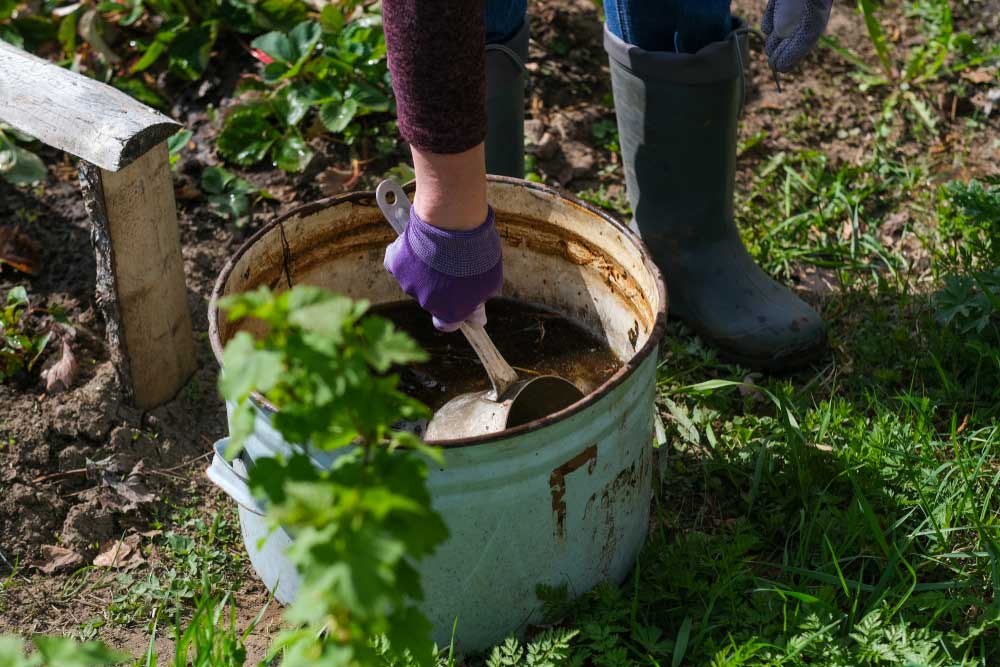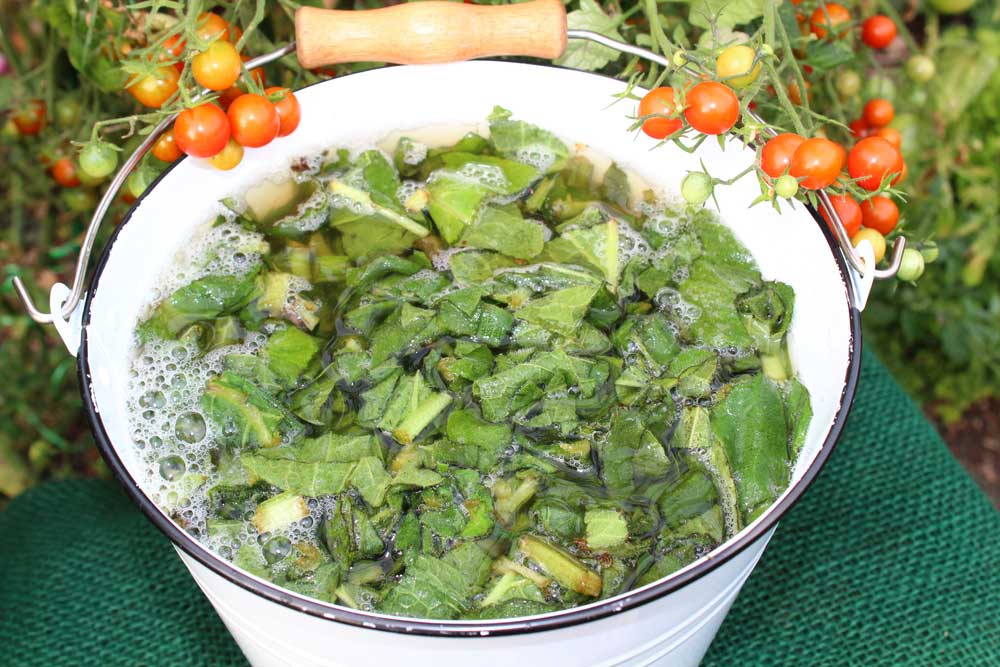Comfrey is a gardener’s secret weapon for creating powerful, natural fertilizer right at home. This amazing plant is packed with nutrients that help your garden thrive without the need for store-bought chemicals. The best part? Making your own comfrey fertilizer is simple and costs almost nothing if you grow the plant yourself.
You can make comfrey fertilizer by harvesting fresh leaves, tearing or crushing them, and then either blending them with hot water for immediate use or packing them in a covered container to create a concentrated liquid feed.
This nutrient-rich solution gives your plants a healthy boost, especially during their growing season when they need extra support.
Want to avoid the notorious smell that comes with many homemade plant feeds? Don’t worry! There are several methods to create comfrey fertilizer that won’t drive away your neighbors.
From quick blender methods to longer steeping techniques, you’ll find an approach that works for your garden needs and schedule.
Understanding Comfrey and Its Benefits
Comfrey is a powerhouse plant that offers amazing benefits for your garden. This remarkable herb works as a natural fertilizer that can transform your gardening experience without chemicals.
What Is Comfrey?

Comfrey (Symphytum officinale) is a perennial herb with large, hairy leaves and bell-shaped flowers that range from purple to white. It grows quickly and can reach 3-5 feet tall when mature.
What makes comfrey special is its deep taproot system. These roots can extend up to 10 feet into the soil, mining nutrients and minerals that other plants can’t reach.
Comfrey is often called a “dynamic accumulator” because it pulls elements like potassium, calcium, magnesium, and iron from deep underground and concentrates them in its leaves.
You can grow comfrey easily in most gardens. The “Bocking 14” variety is popular among gardeners because it’s sterile and won’t spread uncontrollably through seeds.
Nutritional Value and Advantages for Plants
Comfrey leaves are packed with nutrients that plants love. They contain approximately:
- Nitrogen (N): Promotes leaf growth
- Phosphorus (P): Supports root development
- Potassium (K): Enhances flowering and fruiting
The potassium content is especially high, making comfrey tea perfect for feeding flowering and fruiting plants like tomatoes and peppers.
Using comfrey fertilizer gives you several advantages over store-bought options:
- It’s completely free if you grow your own plants
- It’s 100% organic with no harmful chemicals
- It recycles nutrients already in your garden ecosystem
- Plants absorb it quickly for fast results
You can harvest comfrey leaves multiple times during the growing season. Each plant can typically provide 4-5 cuttings per year, giving you plenty of material for making fertilizer.
Gathering Comfrey Leaves
Comfrey leaves are packed with nutrients that make them perfect for creating homemade fertilizer. These nutrient-rich leaves contain potassium, nitrogen, and other minerals that plants love.
Best Time to Harvest
The ideal time to harvest comfrey leaves is during the growing season, from late spring through early fall. During this period, the plants are actively growing and producing nutrient-rich foliage.
Harvest leaves when they’re fully developed but before the plant flowers for maximum nutrient content. Many gardeners cut comfrey 3-4 times per season, allowing about 5-6 weeks between harvests for regrowth.
Morning is the best time to collect leaves when their moisture content is highest. Avoid harvesting after rain as wet leaves can develop mold during processing.
You’ll know it’s time to harvest when leaves are large and lush, typically measuring 6-8 inches long or more.
Safe Collection Practices

Always wear gloves when handling comfrey as the tiny hairs on the leaves can irritate skin. Long sleeves are also helpful to protect your arms from potential irritation.
Use clean, sharp scissors or pruning shears to cut leaves at the base of the stem. This clean cut helps the plant recover faster than if you tear or pull leaves off.
Don’t harvest more than two-thirds of the plant at once to ensure healthy regrowth. Leave the smaller, inner leaves to continue growing.
Collect leaves in a clean container or basket that allows for air circulation. Avoid plastic bags which can cause leaves to sweat and break down too quickly.
Shake off any insects before bringing leaves indoors for processing.
Creating Your Comfrey Fertilizer
Making your own comfrey fertilizer is simple and will provide your plants with valuable nutrients. You can create different types based on your gardening needs and the time you have available.
Comfrey Tea Preparation
Comfrey tea is one of the easiest fertilizers to make. Start by harvesting fresh comfrey leaves, wearing gloves to protect from the scratchy hairs. You’ll need about a bucket full of leaves.
Place the leaves in a bucket and cover them with water. Use a brick or heavy stone to keep the leaves submerged.

Cover the bucket with a lid but don’t seal it completely. This allows gases to escape while keeping rain out. Let it steep for 3-4 weeks.
The mixture will start to smell quite strong – that’s normal! When ready, strain the liquid and dilute it with water at a ratio of 1:10 before applying to your plants.
Comfrey Liquid Fertilizer Method
For a quicker and less smelly option, try making concentrated comfrey liquid. Pack fresh comfrey leaves tightly into a container with drainage holes at the bottom.
Place this container above another container to catch the liquid. Put a weight on top of the leaves to help press out the nutrients.
No water is needed for this method! The leaves will break down naturally and release a thick, dark liquid rich in nutrients.
This concentrate is powerful stuff. Dilute it at a ratio of about 1:15 with water before using on your plants. This method typically takes 1-2 weeks to produce usable fertilizer.
Application of Comfrey Fertilizer
Applying comfrey fertilizer correctly will help your plants thrive while maximizing the benefits of this powerful homemade plant food. Timing and proper dilution are key to getting the best results in your garden.
When and How to Apply

The best time to apply comfrey fertilizer is during the growing season when plants need extra nutrients. For vegetables, apply when plants start actively growing and again when flowering begins. Fruiting plants like tomatoes and peppers benefit from applications every 2-3 weeks during their productive phase.
Pour the liquid fertilizer directly at the base of plants, avoiding the leaves when possible. Early morning or evening applications work best to prevent leaf burn. Rainy days aren’t ideal as the fertilizer might wash away before plants absorb it.
Comfrey tea works well for both outdoor gardens and container plants. For potted plants, apply less frequently—every 3-4 weeks is usually sufficient.
Dosage and Concentration Tips
Dilute your comfrey tea before application to avoid overwhelming your plants. A general rule is to mix 1 part comfrey tea with 10 parts water for regular feeding. For younger or more sensitive plants, use a weaker solution (1:15 or even 1:20).
Different plants have different needs:
- Heavy feeders (tomatoes, cucumbers): 1:10 ratio every 2 weeks
- Moderate feeders (peppers, leafy greens): 1:15 ratio every 3 weeks
- Light feeders (herbs, root vegetables): 1:20 ratio monthly
Test a small area first if you’re unsure about concentration. Watch for signs of over-fertilization like excessive leaf growth with few flowers or fruits.
For foliar application, dilute even further (1:20) and spray early morning when leaves can dry before the hot sun arrives.
Storing Homemade Comfrey Fertilizer
Proper storage of your comfrey fertilizer will help maintain its potency and extend its usability. With the right containers and conditions, you can keep your garden supplied with this nutrient-rich plant food throughout the growing season and beyond.
Short-term Storage Solutions
For immediate use within a few weeks, store your comfrey fertilizer in a sealed container in a cool, shaded area. Plastic containers with tight-fitting lids work well, but make sure they’re labeled clearly.
Glass bottles or jars are excellent options too. They don’t absorb odors and can be thoroughly cleaned for reuse.
Always keep your comfrey tea away from direct sunlight, as heat can cause fermentation and increase pressure in sealed containers. A garage, garden shed, or basement provides ideal conditions.
When storing for just a few days, you can dilute the fertilizer only when you’re ready to use it. This helps maintain its strength and prevents deterioration of the nutrients.
Long-term Preservation
For storage beyond a few weeks, choose dark containers that block light to prevent algae growth. Thoroughly clean and sterilize all storage containers first.
Consider freezing your comfrey tea in ice cube trays for easy portioning. Once frozen, transfer the cubes to labeled freezer bags. This method preserves nutrients effectively for up to a year.
For liquid storage, adding a tablespoon of natural preservative like salt or vinegar per gallon can help extend shelf life by slowing bacterial growth.
Store in a consistently cool location with temperatures between 40-50°F (4-10°C) for best results. Check your fertilizer occasionally for any signs of contamination like unusual colors or excessive mold growth.




